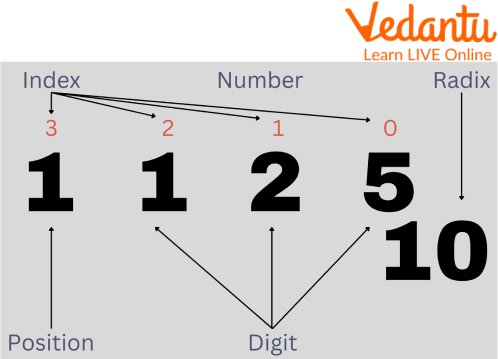




Overview of the Radix of the Number System
You must have heard of the term ‘radix’ or ‘base’ if you have read enough about mathematical numeral systems. In the number system, the radix or base is the number of distinct digits, including the digit zero, used to represent numbers in a positional numeral system. For instance, the radix (base number) for the decimal system, which is currently the most popular system, is ten since it employs the ten digits from 0 to 9. In this article, we will learn about the value of radix in binary number system and its position.
What Is the Number System?
A number system is a representation of numbers. It is also known as the numeration system, which defines a set of values representing a quantity. These numbers are used as digits, the most common being 0 and 1, representing binary numbers. Other forms of number systems are represented by digits ranging from 0 to 9.
Base of the Number System
The number system base is the total number of digits present in the number system. For example, if the number system has the base ‘b’, it has its digits in the [0, b-1] range. This base of the number system is often called the radix of a number system.
Radix of the Number System
Radix of the number system, as in ‘base’, refers to the base of the number system: the possible number of existing digits. Radix is the concept used to explain the number of digits utilised in positioning the number system before going to the next digit. It consists of 0, and 1, 2, 3, 4, 5, 6, 7, 8, 9, and the best example of a radix number could be the binary system.
For example, in the base 10 number system, there are a total of 10 digits used (zero through nine). Therefore, its radix is 10. Another way of putting this could be: the single number obtained from the date of birth is called a radix. For example, if your birthday is on the 14th, then 1+4 = 5. This way, the number of people born on the 14th is 5.

Number System Conversions
Converting from Decimal to Another Radix (Base) Number
To convert a decimal number into a radix or base number, we will use the method of successive division.
Let us begin by taking a random number, for example, 12573. We will divide this decimal number by 10 and note down its remainder. After dividing 12573 by 10, we get the quotient as 1257 and the remainder as 3. The remainder of the division is considered the least significant digit of the original number. Repeat the same step and note down the remainder you get, which will be 7 now.
Now let us divide the decimal number by 37 with its base to convert it into a radix number. The base of the number is 2. To show this division understandably and conveniently, we have sorted the base, the divisor, the new digit, and the remainder in separate columns. When we perform a bunch of divisions on 37 by 2, the column looks like this.
The results obtained in the form of the least significant digit are read from the bottom of the column. If we begin working from the bottom of the table's rightmost column, we get the result as 100101.
As we perform continuous divisions, this method is called the method of successive division. Sometimes also known as the division algorithm. This method converts a decimal number into a binary number by dividing it by our intended radix or base on every step.
Position Number System
The position number system expresses numbers in which the digits are arranged in succession, the position of each digit has a place value, and the number is equal to the sum of the products of the place values of each digit. The numbers expressed in their value are called position number system values.
The Roman number system uses symbols to represent numerals. Therefore, it cannot be called a positional number system. On the other hand, the octal number system uses numbers ranging from 0 to 7. The binary number system uses digits from 0 to 1. Similarly, a number system that uses numbers ranging from 0 to 15 is called the hexadecimal number system.

Stating the Number Value
A positional number system is a system in which
(i) a number in the system is represented by an ordered set of digits,
(ii) the value of a number is the total sum of the values of each digit, and
(iii) the values contributed by each digit depend on (a) its position and (b) its value.
Solved Examples
Q1. Find $r$ such that $(121) r=(144)_8$, where $r$ and 8 are the bases.
Ans: $144_8=1 \cdot 8^2+4 \cdot 8^1+4 \cdot 8^0=64+32+4=100$,
$121_r=1 \cdot r^2+2 \cdot r^1+1 \cdot r^0=r^2+2 r+1$
Solve the quadratic equation to find $r$
$r^2+2 r+1=100$
by whatever method you find the most convenient; the easiest method is probably to notice that $r^2+2 r+1=(r+1)^2$
Therefore, $(r+1)^2=100=10^2$
$\mathrm{r}+1=10$
$r=10-1$
$r=9$
So the base or radix is 9.
Q2. What is the radix of the quadratic equation $x^2-10 x+26=0$? The roots are $x=4$ and $x=7$.
Ans: $\mathrm{x}^2-10 \mathrm{x}+26=0$
$(4)^2-\left(1 \cdot r^1+0 . r^0\right) \times 4+\left(2 \cdot r^1+6 \cdot r^0\right)=0$
$16-4 r+2 r+6=0$
$2 r=22$
$r=11$
The radix of the quadratic equation $x^2-10 x+26=0$ is 11.
Practice Problems
Q1. How many digits are present in the radix 9 number system?
Ans: In the base/radix 9 number system, there are 9 digits. The digits would be 0, 1, 2, … and so on, 8 being the largest number.
Q 2. Show that 0.3333… can be expressed as a rational number, i.e., $\dfrac{p}{q}$.
Ans: $x = \dfrac{1}{3}$
Q 3 . Find the sum of $2 \sqrt{ } 2+5 \sqrt{ } 3$ and $\sqrt{ } 2-3 \sqrt{ } 3$.
Ans: $3 \sqrt{ } 2+2 \sqrt{ } 3$
Summary
We now understand that Radix numbers can be found almost everywhere. The two digits are ‘0’ and ‘1’. The number 0 is expressed for switches displaying OFF, and the number 1 is expressed for displaying ON. These numbers are used in most electric counters and nearly all computers. In this article, we learned that a Binary Number System with two independent digits is called a base-2 number system. All the larger types of binary numbers are represented as ‘1’ and ‘0’.
FAQs on What is the Radix of the Number System?
Q1. What are the 4 types of number systems?
Ans: There are four main types of number systems which include:
Binary number system (Base - 2)
Octal number system (Base - 8)
Decimal number system (Base - 10)
Hexadecimal number system (Base - 16)
Q2. Is radix the same as the base?
Ans: Base, also called radix, in Mathematics, is an arbitrarily chosen whole number greater than 1 in terms of which any number can be expressed as a sum of that base raised to various powers. The decimal number system commonly used expresses all numbers in base 10.
Q3. Which number system whose radix is 8?
Ans: The octal numeral system, or oct for short, is the base-8 number system, and uses the digits 0 to 7.











